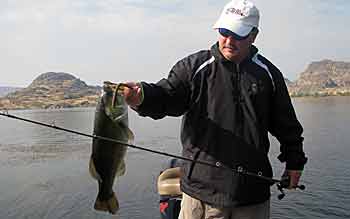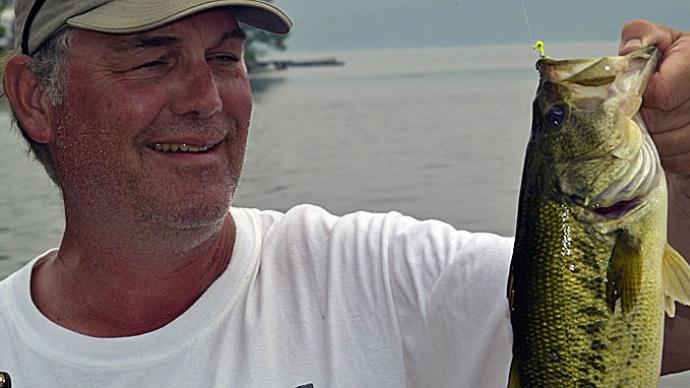
First, let us discuss tackle. The rod is the most critical piece of equipment. You are looking for a very sensitive rod at the tip yet has a lot of backbone for setting the hook and horsing fish from cover. In today's world, rods made explicitly for worm fishing are available in all price ranges and weights. I use All Star rods exclusively. These rods are made from IM8 graphite blanks, 7 feet long, in a heavy- to medium-heavy weight, making them very sensitive; they have a lot of backbone, and you can feel the bite without any trouble. The price is nominal, but if the price is too high for you, look at the Tourney Special rods at Bass Pro Shops. The point is that any of these rods provide the sensitivity or "feel" you need for worm fishing. I recommend buying at least one of each weight.
While you are in a buying mood, another rod is needed at some point: a flipping stick. Flipping sticks are generally heavy-weight rods made for heavy cover and horsing fish from heavy cover. They are generally at least 7-foot 3-inches long.
The reel is primarily up to your preference. A good bait cast reel is what I prefer, but my son-in-law prefers a spinning reel, and my wife prefers Zebco 33s. You determine what reel you want to use, but do not skimp. Get good quality reels that will last a long time. The reel you choose should be a low- to medium-speed reel for worm fishing. You don't want to use a high-speed reel for worm fishing as this will speed up your retrieves, thus causing you to fish much too fast under normal conditions.
Whatever type of reel you decide on, do not forget to do some comparison shopping for the best price. Baitcast reels run the whole gambit of price. Look for a reel with at least 3 to 5 ball bearings, a good drag system, and substantial gears for wear over a long period. Another thing to look for in a baitcast reel is a flipping feature. I will discuss flipping later. If you prefer a spinning reel, do the necessary comparison shopping for the best reel at the best price.
The line is the next consideration. I have used many lines since I began fishing and prefer fluorocarbon. If you are comfortable with braid, use it.
One rather important thing is the line size. I use a line as small as possible for the particular lake or river conditions I am fishing. For instance, when I fish Lake Ouachita, which is very clear, I use 12-pound Seaguar InvizX. When I fish the Arkansas River, I will use 14-20 pound line because it is generally muddy to slightly stained. The point is to use the smallest diameter line for your fishing conditions. IT DOES MAKE A DIFFERENCE.
Case in point: Last year, my son-in-law and I were worm fishing on Lake Ouachita. I had caught four keeper bass, and he had yet to get a bite. "Why?" he asked. We took stock of what we were using, and sure enough, he was using 20-pound line. We left to eat breakfast. When we returned, he changed to 12-pound line and, within a short time, began to catch fish. IT DOES MAKE A DIFFERENCE.
Buy line in the large spools as worm fishing, especially in heavy cover, tends to abrade and wear your line. This causes frequent cut-offs of two to three feet of line. Bulk spools also are more economical. Do not go overboard, but remember, at some point, you will be fishing 12- to 14-pound and 20 - to 30-pound lines. Buy as many different spools of line as is practical, prudent, and affordable.
Hooks and weights are the next consideration. The hook needs to be a relatively wide-gap hook in the 2/0 to 4/0-size range for 7- to 8-inch worms. I used three different hook brands and found all to be acceptable. The 2/0 and 3/0 Owner hooks, 2/0 and 3/0 Gamakatsu hooks, and the Eagle Claw Laser Sharp 2/0 to 4/0 hooks are all extremely sharp and have good hook-set capabilities.
This is the place to discuss the red hook. Do they attract more bites? The answer depends on whom you listen to. The hook manufacturers have conducted exhaustive research into the red hook. They concluded that the color red triggers bass, indicating a wounded prey.
My wife and I have used the red hooks for the last year. I have used the red hook, and she has stayed with the bronze finish hooks. There may be a slight advantage of the red hook over a standard hook, but it is not enough of a difference to worry about.
Weights are another consideration. I use weights sized by the fishing depth or prevailing conditions. Use weights as small as practical for the depth and conditions you are fishing. Rule of thumb for me: fishing 0 to 18 feet, no or little wind, use a 1/8 ounce weight, either brass (the better environmental choice) or lead. O to 18 feet with wind, upsize to ¼ ounce weight for a better "feel." For 18 to 39 feet, I use ¼ ounce weight, and if windy, upsize to 3/8 ounce weight. I use bullet weights for the most part, but the "egg" or round weights also work. These weights let the worm appear more lifelike in the action it demonstrates and do not kill the action. USE THE SMALLEST WEIGHT YOU CAN FOR PREVAILING CONDITIONS.
A tip to use when fishing gets tough: put a glass bead or brass clacker between the hook and the weight or use the rattling weight for clicking noises while worm fishing. The rattling weights are a little pricey, but they can put a limit in the live well. This can produce surprising results at times.
Worms come in all shapes, sizes, and colors and are all designed to catch fishermen, not necessarily fish. I will not try to influence your worm choice other than to say that the type of worm I use has a "swimming" tail that imparts more lifelike action than straight or curly-tail worms. That is my preference, but I have seen situations where straight worms work better. Colors either have to be learned from experience or experiment. I prefer the swimming tail worms for Texas rigging because of the better action you get with that type of worm and tail configuration. The ribbon tail and ringer worm are my preferences. You choose the worms in which you have the most confidence. In addition, using lizards, craw worms, and brush hogs with the Texas rig is possible, so do not discount using them. The colors are up to you.
I am sure you have heard the old saying light day, light color, dark day, dark color, and clear water, natural color, dark water, bright colors. Most of that holds true in deciding what worm you should be throwing. I try to keep my plastic colors as simple as possible. You only need a few colors. I use watermelon seed, pumpkinseed, plum, and redbug for clear water waters. For stained/muddy water conditions, I use tequila sunrise, red shad, black, black/blue tail, and camouflage (very hard to find). I can fish all water under all conditions if I have those colors in various shapes and sizes. The colors mentioned above represent my favorites, but make no mistake; I still have about 20 other colors to fall back on when the favorites fail to produce.
Other colors are Junebug, purple, red shad, black/red metal flake, motor oil, and root beer / green metal flake.

The basis for this article is the professional bass fishing career of Carlton "Doc" Holliday. I made many mistakes and point them out in this book. I intend to help you become a better worm fisherman in less time without my mistakes. I have also inserted some helpful tips to make your experience easier.
Carlton "Doc" Holliday has won over 30 bass tournaments, individually and as a team member with his wife, and placed in the top 5 in over 70 bass tournaments. The last three years of his career as a professional bass fisherman were spent winning the Arkansas Guys and Gals Championship with his wife in 1991, finishing seventh overall in the Arkie Division of the Redman Circuit in 1991, and becoming eligible to fish the Redman Regional Tournament in Columbus Mississippi where he finished 20th. Also, in 1990, I fished in the Mr. Bass of Arkansas Championship on Lake Ouachita and finished third. Career winnings are estimated at over $85,000.00, but remember, bass tournaments did not pay the big bucks back then that they pay now.




